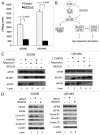Dual PI3K/mTOR inhibitor NVP-BEZ235 suppresses hypoxia-inducible factor (HIF)-1α expression by blocking protein translation and increases cell death under hypoxia
- PMID: 22895065
- PMCID: PMC3461816
- DOI: 10.4161/cbt.21144
Dual PI3K/mTOR inhibitor NVP-BEZ235 suppresses hypoxia-inducible factor (HIF)-1α expression by blocking protein translation and increases cell death under hypoxia
Abstract
The PI3K/Akt pathway is activated in many cancers; therefore, we investigated NVP-BEZ235, a dual PI3K/mTOR inhibitor. BEZ235 was more potent than either the mTOR inhibitor rapamycin or the PI3K inhibitor LY294002 in blocking HIF-1α induction. BEZ235 decreases protein translation, and 7-methyl GTP chromatography showed that the drug induced robust recruitment of 4E-BP1 to eIF4E and a near absence of binding of eIF4G. BEZ235 also decreased expression of other proteins known to be regulated by eIF4E including cyclin B1 and D1 and vascular endothelial growth factor (VEGF). BEZ235 also decreased the level of eIF4G but not eIF4E. As HIF-1α has been associated with adaptation to hypoxic stress, we examined the effect of the drug on cell survival in low pO 2. BEZ235 increased killing of cells under hypoxia, measured by short-term (MTT) and long-term (clonogenic) assays. To understand the underlying mechanism, we examined BEZ235's effect on the expression of factors associated with cell survival. Under normoxia, Akt Ser473 phosphorylation decreased within an hour of BEZ235 treatment, but then increased by 24 h. In contrast, under hypoxia, BEZ235 caused prolonged suppression of Akt Ser473 phosphorylation. Furthermore, there was greater PARP cleavage in hypoxic cells than in normoxic cells, consistent with increased apoptosis. BEZ235 increased autophagy as measured by LC3-I to LC3-II conversion under both normoxic and hypoxic conditions, but our data indicate that this is actually a pro-survival mechanism. In conclusion, we have found that BEZ235 blocks HIF-1α induction by decreasing protein translation and increases cell killing under hypoxia, likely by increasing apoptosis.
Figures




Similar articles
-
Efficacy of the dual PI3K and mTOR inhibitor NVP-BEZ235 in combination with imatinib mesylate against chronic myelogenous leukemia cell lines.Drug Des Devel Ther. 2017 Apr 3;11:1115-1126. doi: 10.2147/DDDT.S132092. eCollection 2017. Drug Des Devel Ther. 2017. PMID: 28435223 Free PMC article.
-
Dual PI3K/mTOR inhibitor NVP-BEZ235-induced apoptosis of hepatocellular carcinoma cell lines is enhanced by inhibitors of autophagy.Int J Mol Med. 2013 Jun;31(6):1449-56. doi: 10.3892/ijmm.2013.1351. Epub 2013 Apr 16. Int J Mol Med. 2013. PMID: 23588698
-
Inhibition of Autophagy Increases Proliferation Inhibition and Apoptosis Induced by the PI3K/mTOR Inhibitor NVP-BEZ235 in Breast Cancer Cells.Clin Lab. 2015;61(8):1043-51. doi: 10.7754/clin.lab.2015.150144. Clin Lab. 2015. PMID: 26427150
-
Dual Roles of the AMP-Activated Protein Kinase Pathway in Angiogenesis.Cells. 2019 Jul 19;8(7):752. doi: 10.3390/cells8070752. Cells. 2019. PMID: 31331111 Free PMC article. Review.
-
The role of Hypoxia-Inducible Factor-1alpha and its signaling in melanoma.Biomed Pharmacother. 2021 Sep;141:111873. doi: 10.1016/j.biopha.2021.111873. Epub 2021 Jul 2. Biomed Pharmacother. 2021. PMID: 34225012 Review.
Cited by
-
Hypoxia Promotes Glioma Stem Cell Proliferation by Enhancing the 14-3-3β Expression via the PI3K Pathway.J Immunol Res. 2022 May 14;2022:5799776. doi: 10.1155/2022/5799776. eCollection 2022. J Immunol Res. 2022. PMID: 35607406 Free PMC article.
-
Macrophage Motility in Wound Healing Is Regulated by HIF-1α via S1P Signaling.Int J Mol Sci. 2021 Aug 20;22(16):8992. doi: 10.3390/ijms22168992. Int J Mol Sci. 2021. PMID: 34445695 Free PMC article. Review.
-
Enhancement of cardiac angiogenesis in a myocardial infarction rat model using selenium alone and in combination with PTXF: the role of Akt/HIF-1α signaling pathway.Naunyn Schmiedebergs Arch Pharmacol. 2024 Jul;397(7):4677-4692. doi: 10.1007/s00210-023-02904-9. Epub 2023 Dec 19. Naunyn Schmiedebergs Arch Pharmacol. 2024. Retraction in: Naunyn Schmiedebergs Arch Pharmacol. 2025 Apr;398(4):4665. doi: 10.1007/s00210-025-03935-0. PMID: 38112730 Free PMC article. Retracted.
-
Gambogic acid suppresses hypoxia-induced hypoxia-inducible factor-1α/vascular endothelial growth factor expression via inhibiting phosphatidylinositol 3-kinase/Akt/mammalian target protein of rapamycin pathway in multiple myeloma cells.Cancer Sci. 2014 Aug;105(8):1063-70. doi: 10.1111/cas.12458. Epub 2014 Jul 27. Cancer Sci. 2014. PMID: 24890366 Free PMC article.
-
Inhibitors of the PI3K/mTOR pathway prevent STAT5 phosphorylation in JAK2V617F mutated cells through PP2A/CIP2A axis.Oncotarget. 2017 May 22;8(57):96710-96724. doi: 10.18632/oncotarget.18073. eCollection 2017 Nov 14. Oncotarget. 2017. PMID: 29228564 Free PMC article.
References
-
- Maira SM, Stauffer F, Brueggen J, Furet P, Schnell C, Fritsch C, et al. Identification and characterization of NVP-BEZ235, a new orally available dual phosphatidylinositol 3-kinase/mammalian target of rapamycin inhibitor with potent in vivo antitumor activity. Mol Cancer Ther. 2008;7:1851–63. doi: 10.1158/1535-7163.MCT-08-0017. - DOI - PubMed
Publication types
MeSH terms
Substances
Grants and funding
LinkOut - more resources
Full Text Sources
Molecular Biology Databases
Research Materials
Miscellaneous
